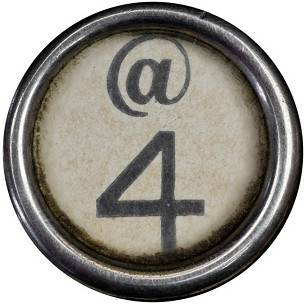
The @ symbol is the character of the internet age, but no one really knows where it came from.
En el pasado, pocos usaban el signo “arroba”. Más que todo, era útil para comerciantes o contadores.
But this changed thanks to Ray Tomlinson, the man considered by many to be the inventor of email.
- Ray Tomlinson, inventor of email, dies
He ripped the @ off his keyboard in 1971 to place it between the username and the destination address when he sent the first message between two computers in his office, and so on. it changed the future of the curious doodle that until then had had a dignified life but without frights, sharing a key with a number.
Tomlinson chose @ because it was rarely used in computing at the time, and he wanted to avoid confusing older programs or operating systems.
En una feliz coincidencia, el nombre de inglés del símbolo se ajustaba muy bien: “at” que significa “en”.
- Time to say goodbye to email?

En inglés, “el símbolo @ apareció en las máquinas de escribir antes del final del siglo XIX”, le dice a la BBC Keith Houston, autor de “Caracteres oscuros: La vida secreta de puntuación”.
“Parecía ser un símbolo general que significaba ‘esta cantidad de cosas a este precio’. No tenía más uso”.
And, because typewriters included it, so did the first keyboards suitable for computers.
“The @ symbol was part of keyboards, because it was a work tool and had a commercial use“, señala Houston.
It was understood by business users as a symbol to indicate the unit price, for example: 12 tissues @ £ 1 each.
Further back and elsewhere
In 2000, Italian academic Giorgio Stabile observed that many nations use different words for the @ symbol that describe what it looks like.
En turco es “rosa”, mientras que en noruego, “cola de cerdo”. En griego es “patito” y en Hungría es “gusano”.
Stabile further noted that in French, Spanish and Portuguese it referred to arobase or arroba, the unit of weight and volume.
En italiano el nombre para el símbolo es “ánfora”, en referencia a las jarras de almacenamiento de cerámica con cuello largo que se usaban desde la antigüedad.

Stabile discovered a letter sent from Seville to Rome in 1536, discussing the arrival in Spain of three ships sailing from the New World.
Indicaba que se había vendido un ánfora de vino y “ánfora” había sido reemplazada con el símbolo @ como una abreviatura.
Stabile concluded the @ symbol was a common medieval shorthand for units of measurement in southern Europe, even if the precise units differed.
The Spanish journalist Jorge Pareja then found an even older use.
“I have read about the 16th century example of @ and remembered that I had seen the symbol before, cuando era un estudiante de historia en la Universidad de Zaragoza. Revisé mis viejos papeles y encontré registros de aduana entre Aragón y Castilla en el siglo XV. Significaba ‘arroba’ como una medida de peso, y en este caso una arroba de trigo”.
@ men

But the oldest reference discovered until the @ symbol is a religious one. It appears in a Bulgarian translation of a Greek chronicle dating from 1345.
It is located in the Vatican Apostolic Library, and the @ symbol appears in place of the A in the word 'Amen'. The reason it was used in that context is a mystery.
It seems fitting then that the first email sent with the @ symbol was also lost in time.
When Tomlinson sent the first message to [email protected], he didn't anticipate how revolutionary it would be so he didn't bother to save it.














No Comment